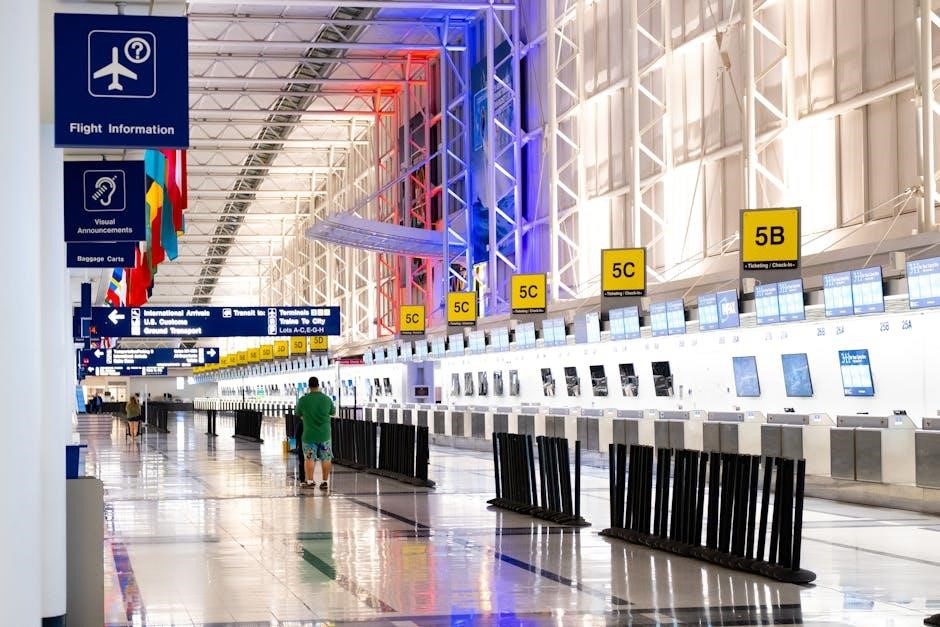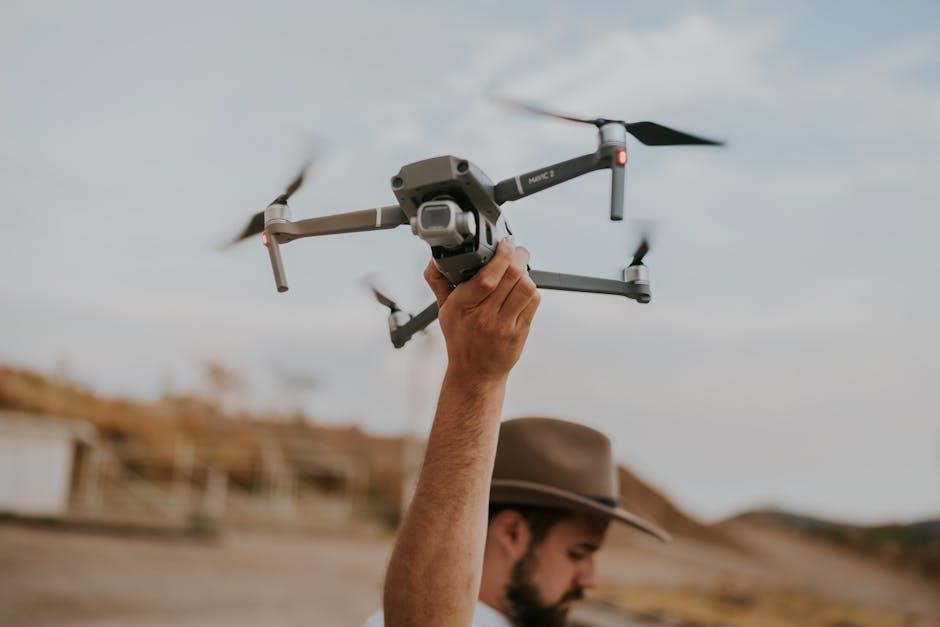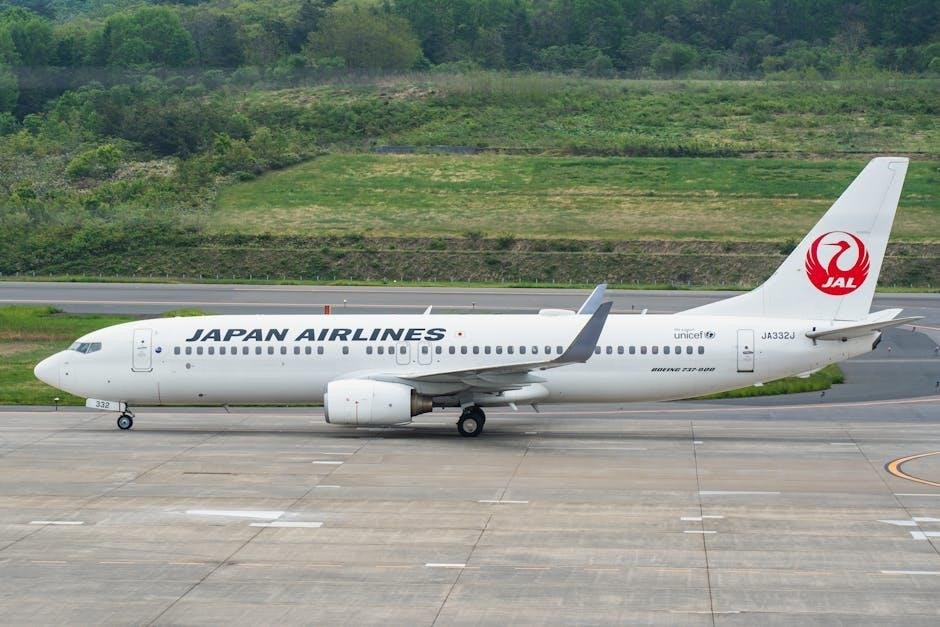Aviation is a vital global industry connecting billions worldwide, ensuring efficient travel and cargo transport. It emphasizes safety, efficiency, and reliability, driven by continuous technological advancements. From commercial flights to private jets, aviation shapes economies and fosters international relations, making it indispensable in modern society.
Overview of the Aviation Industry
The aviation industry is a global network connecting billions of people and goods annually. It encompasses commercial airlines, private jets, military aircraft, and cargo transport, playing a critical role in the economy. Airlines operate over 100,000 flights daily, employing millions and generating significant revenue. The industry relies on advanced infrastructure, including airports, air traffic control, and safety protocols, ensuring efficient and secure operations worldwide.
Key Components of Aviation
Aviation comprises several critical components: aircraft design, airports, air traffic control, and regulatory bodies. Advanced technologies like GPS and radar ensure safe navigation. Skilled professionals, including pilots and engineers, maintain operations. Additionally, environmental and safety standards are essential for sustainable growth. These elements work together to enable efficient, secure, and reliable air travel, supporting global connectivity and economic development.

History of Aviation
Aviation began with the Wright brothers’ first powered flight in 1903, evolving through World Wars and technological leaps to become a global transport backbone, shaping modern connectivity.
Early Years of Aviation
The early years of aviation were marked by groundbreaking innovations, starting with the Wright brothers’ historic flight in 1903. Pioneers like Lilienthal and Chanute laid the groundwork with glider experiments. World War I accelerated advancements, leading to the development of more powerful engines and improved designs. These milestones set the stage for the transformative impact of aviation on global connectivity and commerce and established the foundation for modern aviation.
Modern Developments in Aviation
Modern aviation has seen significant advancements, including the use of advanced composite materials, more efficient engines, and improved aerodynamics. Automation and AI are transforming flight operations, enhancing safety and precision. Electric and hybrid-electric aircraft are emerging, promising sustainability. Additionally, the integration of big data and IoT optimizes performance, while alternative fuels like Sustainable Aviation Fuel (SAF) aim to reduce carbon emissions, paving the way for a greener and more efficient future in aviation.

Types of Aircraft
Aviation encompasses various aircraft types, including commercial airliners, military planes, private jets, and general aviation aircraft, each serving distinct purposes in transportation and specialized operations.
Commercial Aircraft
Commercial aircraft are designed for passenger and cargo transport, enabling global connectivity. They include passenger planes, cargo planes, and regional jets, varying in size and range. These aircraft operate on scheduled routes, connecting cities and countries. Advances in technology have improved fuel efficiency and reduced noise pollution. Airlines rely on these planes to meet growing travel demand, supporting economic growth and international trade.
Military and Private Aircraft
Military aircraft are specialized for defense and combat, including fighters, transport planes, and surveillance aircraft. Private aircraft, such as business jets and helicopters, offer luxury and convenience for individuals and corporations. These aircraft often feature advanced technology and customization, catering to specific needs. Both sectors play crucial roles in national security and personal transportation, highlighting aviation’s diverse applications beyond commercial flights.
Aviation Infrastructure
Aviation infrastructure includes airports, air traffic control systems, and ground facilities, ensuring safe and efficient flight operations. Continuous advancements in technology and infrastructure meet growing demands and improve safety standards.
Airports and Their Operations
Airports are critical hubs for aviation, facilitating passenger and cargo movement. Operations include check-in, security screening, and baggage handling. Air traffic control ensures safe takeoffs and landings. Ground staff manage aircraft maintenance, fueling, and ground transportation. Advanced technology, such as biometric systems and automated baggage sorting, enhances efficiency and security. Effective airport management is vital for smooth flight operations and passenger satisfaction, making it a cornerstone of modern aviation infrastructure.
Air Traffic Control Systems
Air traffic control systems are essential for ensuring safe and efficient aircraft movement. They coordinate takeoffs, landings, and en-route operations using advanced radar, communication, and navigation tools. Controllers monitor flight paths, manage separation between aircraft, and adapt to weather or traffic conditions. These systems integrate with airport operations, airlines, and aviation authorities to maintain seamless global air travel, prioritizing safety and minimizing delays.
Flight Process
The flight process involves pre-flight checks, takeoff, cruising, and landing, ensuring safety and efficiency. Each phase requires precise coordination between pilots, air traffic control, and ground staff.
Pre-Flight Procedures
Pre-flight procedures ensure aircraft safety and readiness. Pilots conduct detailed inspections, review weather conditions, and complete checklists. Air traffic control issues clearance, while cabin crews prepare for takeoff, briefing passengers on safety protocols. These steps are critical for a smooth and secure flight operation.
In-Flight and Landing Procedures
In-flight procedures involve pilots monitoring systems, communicating with air traffic control, and adjusting altitude. Cabin crews ensure passenger safety, serve meals, and prepare for landing by securing the cabin. Landing procedures include descending, configuring flaps, and aligning with the runway. Clear communication with the control tower ensures smooth ground operations. These steps are crucial for a safe and efficient journey, ensuring passenger and crew safety throughout.
Aviation Safety
Aviation safety prioritizes preventing accidents through strict regulations, advanced technology, and rigorous training. Continuous improvement ensures the industry maintains its excellent safety record, protecting passengers and crew worldwide.
Safety Regulations and Standards
Aviation safety regulations are established by global authorities like ICAO and FAA, ensuring uniformity and compliance. These standards cover aircraft design, maintenance, pilot training, and operational procedures. Regular audits and inspections enforce adherence, while updates address emerging risks. Compliance with these regulations is non-negotiable, safeguarding the integrity of flight operations and minimizing hazards. They form the backbone of the aviation industry’s commitment to passenger and crew safety.
Emergency Procedures and Protocols
Aircraft and airports follow strict emergency protocols to ensure passenger and crew safety. These include evacuation drills, fire suppression systems, and emergency communication procedures. Pilots undergo rigorous training for scenarios like engine failure or medical emergencies. Air traffic control coordinates responses, while ground teams prepare for rapid interventions. Regular drills and system checks ensure readiness, minimizing risks and ensuring efficient crisis management during critical situations.
Economic Impact of Aviation
Aviation drives global economic growth by creating jobs, connecting businesses, and enabling international trade. It fosters tourism, boosts productivity, and supports worldwide supply chains efficiently.
Aviation’s Role in Global Economy
Aviation serves as a backbone for the global economy, enabling international trade, tourism, and business connectivity. It facilitates the rapid movement of goods, services, and people, stimulating economic growth. By connecting distant markets, aviation fosters global business opportunities, supports job creation, and enhances cultural exchange. Its role in transporting perishable goods and emergency supplies further underscores its economic and humanitarian significance worldwide.
Job Creation and Industry Growth
Aviation significantly contributes to job creation and industry growth, employing millions globally in roles such as pilots, engineers, and air traffic controllers. Beyond direct employment, it drives indirect jobs in manufacturing, tourism, and logistics. The industry’s expansion, fueled by technological advancements and rising air travel demand, supports economic development and fosters innovation, making it a cornerstone of global employment and industrial progress.

Environmental Considerations
Aviation faces significant environmental challenges, including carbon emissions and noise pollution. The industry is exploring sustainable solutions like electric aircraft and cleaner fuels to reduce its ecological footprint.
Carbon Emissions and Sustainability
Aviation contributes significantly to global carbon emissions, prompting the industry to adopt sustainable practices. Innovations like electric and hybrid aircraft aim to reduce greenhouse gases. Initiatives such as CORSIA and the use of Sustainable Aviation Fuels (SAF) are critical steps toward mitigating climate impact. These efforts align with global goals to achieve net-zero emissions by 2050, ensuring aviation’s environmental sustainability for future generations.
Future of Eco-Friendly Aviation
The future of aviation is poised to embrace eco-friendly technologies, with electric and hybrid-electric aircraft leading the charge. Advances in battery technology and hydrogen-powered engines are expected to significantly reduce reliance on fossil fuels. Sustainable Aviation Fuels (SAF) and innovative aircraft designs will further enhance efficiency. These developments aim to achieve net-zero emissions, ensuring aviation remains a vital yet environmentally responsible mode of transportation for generations to come.

Technological Advancements
Technological advancements are revolutionizing aviation through AI, automation, and electric/hybrid aircraft, enhancing efficiency, safety, and sustainability while reducing environmental impact and operational costs significantly.
AI and Automation in Aviation
AI and automation are transforming aviation by optimizing flight operations, enhancing safety, and improving passenger experiences. AI-powered systems analyze vast data to predict maintenance needs, reducing delays. Autonomous technologies, like self-flying drones and autopilot systems, are increasingly being integrated. These advancements not only reduce human error but also streamline processes, making air travel more efficient and sustainable for future generations.
Electric and Hybrid Aircraft
Electric and hybrid aircraft are emerging as sustainable alternatives to traditional fossil-fuel-powered planes. They utilize electric motors powered by advanced batteries or hybrid systems, significantly reducing carbon emissions and operating costs. While challenges like battery weight and charging infrastructure persist, these aircraft are gaining traction for short-haul and training flights. Innovations in battery technology and government support are paving the way for their widespread adoption in the near future.
Careers in Aviation
Aviation offers diverse career opportunities, from pilots and engineers to air traffic controllers and maintenance specialists. Roles require specialized skills, dedication, and continuous training to ensure safety and efficiency.
Pilot Training and Requirements
Becoming a pilot requires rigorous training and adherence to strict standards. Aspiring pilots must obtain a valid license, complete extensive flight hours, and pass medical exams. They undergo theoretical and practical training, focusing on aircraft operations, navigation, and safety protocols. Continuous education and recurrent training are essential to maintain proficiency and stay updated on aviation regulations. The journey is challenging but rewarding, ensuring safe and skilled aviation professionals.
Other Aviation-Related Professions
Beyond piloting, aviation offers diverse careers such as air traffic controllers, aerospace engineers, and aviation mechanics. These roles ensure safe and efficient flight operations. Air traffic controllers manage aircraft movements, while engineers design and innovate aircraft systems. Mechanics maintain and repair aircraft, ensuring compliance with safety standards. These professions require specialized training and certifications, contributing to the overall functionality and advancement of the aviation industry.
Aviation remains a cornerstone of modern transportation, driving global connectivity and economic growth. Continuous advancements ensure safety, sustainability, and innovation, securing its vital role in shaping the future.
Future Outlook of the Aviation Industry
The aviation industry is poised for transformative growth, driven by advancements in sustainability and technology. Electric and hybrid aircraft are expected to dominate, reducing carbon emissions significantly. AI and automation will enhance efficiency, safety, and passenger experiences. Global demand for air travel will rise, supported by emerging markets and increased connectivity. The industry’s adaptability to challenges ensures its continued evolution, making it a cornerstone of future global transportation and economic development.
Final Thoughts on Aviation
Aviation stands as a cornerstone of modern connectivity, bridging cultures and economies worldwide. Its evolution from humble beginnings to a technologically advanced industry highlights human ingenuity. As it embraces sustainability and innovation, aviation promises a future of greener skies and unparalleled accessibility. This dynamic field will continue to inspire and transform global travel, ensuring its enduring relevance in shaping the world’s future.
